
Status pages are a transparent and effective way to inform users of any downtime or incidents disrupting the company’s service. Without a status page, users are left in the dark, and support tickets pile up, affecting your relationship with them and their trust.
That’s why having a status page is essential for a business in 2024. By showing your current status and incident history or previous downtime, you can keep your users in the loop, and your support team free of numerous reports for a single issue.
That said, making the right status page can be tricky. What information should you include? Can it be tailored to your brand? What is an example of a good status page?
We want to answer these questions by examining the 25 best status page examples in 2024. By adopting some of the communication practices we highlight in these examples, we’re sure you can make the best status page for you.
Do you want to make a clear and informative status page for your business? Let’s jump straight in and look at some status page examples.
What Status Page Examples Are We Looking At?
In this article, we review a variety of businesses to establish what makes a good status page. For example, a status page for a SaaS company would not always work for a school’s status page. As a result, we considered different use cases and gathered status page examples from a variety of services and areas, including:
- Education
- SaaS and Software
- Community and Communication
- Fintech
- E-commerce
Our List – Best Status Page Examples in 2024
Education
- Portland Public Schools
- University Systems of Georgia
- Harvard University
- Massachusets Institute of Technology (MIT)
SaaS and Software
- TrackSSL
- Quickbase
- Datadog
- Amazon Web Services
- DigitalOcean
- Docker
- Heroku
- Cloudflare
- Segment
- Twilio
- GitHub
- Litmus
- NoCodeOps
Community and Communication
Fintech
E-commerce
Education Status Page Examples
1. Portland Public Schools
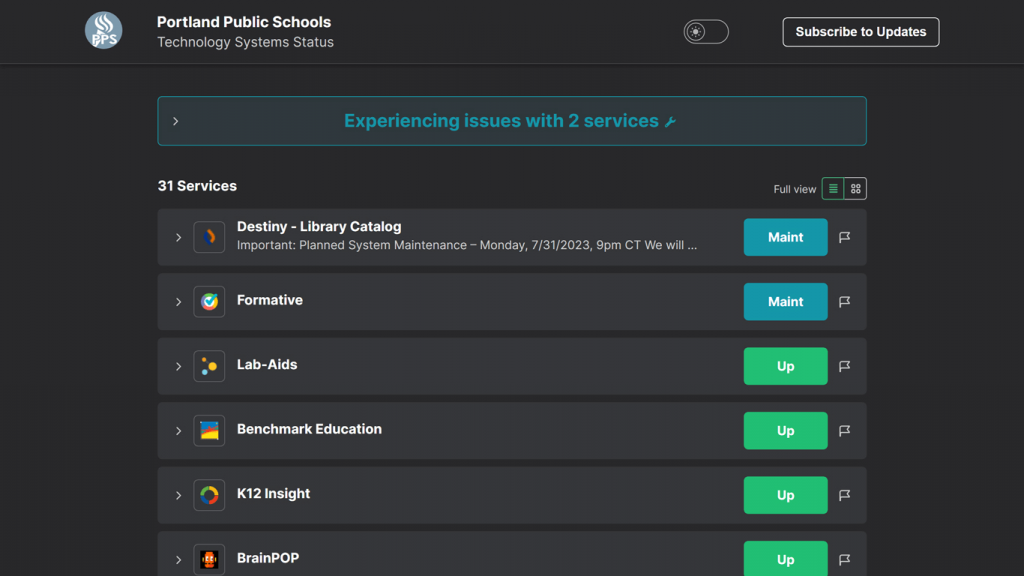
Status Page: https://status.pps.net/
What They Do: They are a public school based in Oregon, USA. Portland Public Schools primarily relies on third-party services. It includes a few LMSs, such as Canvas, Seesaw, and Nearpod. They also rely on different CMS and communication platforms.
What’s Great About Their Status Page? All the statuses of the third-party services they rely on (31 in total) are aggregated into one single status page.
Whenever a disruption occurs, notifications regarding the issue are sent to any assigned groups or subscribers depending on the setup. With immediate communication between all parties, there is no need for the IT staff or school admin to inform teachers and school staff. As a result, the affected parties do not create repeated tickets for the tech team.
In addition to this, the tech team can limit notifications sent to users if the issues do not affect the learning process or override the status.
By using a status page from StatusGator, they can select an option to set up an internal status page for the tech team only.
If a service is experiencing an issue, viewers of the Portland Public School’s status page can expand the service tab to view a particular component of that service or its critical dependency. For example, if there are ongoing issues with numerous AWS Regions inside of the Canvas LMS, viewers can expand the Canvas tab to see this and understand more about the issue.
In the extended tab, viewers can switch between components and history. Users can see the status changes, for any service, for the past thirty days in a compact view. Information regarding incidents is detailed and sufficient.
A noticeable button to subscribe to outage updates is available in the top right corner of the page so you can remain informed.
Their color scheme to categorize incidents is straightforward – red for downtime, yellow for warning, blue for maintenance, and green for the up status.
There’s a switch to change between full and compact views. Dark mode is also available.
Status icons and font style are clear and bold. Users can immediately see the valuable status information at the top of the page.
Overall, their status page is clear and informative, with a straightforward design and useful page attributes.
2. University Systems of Georgia
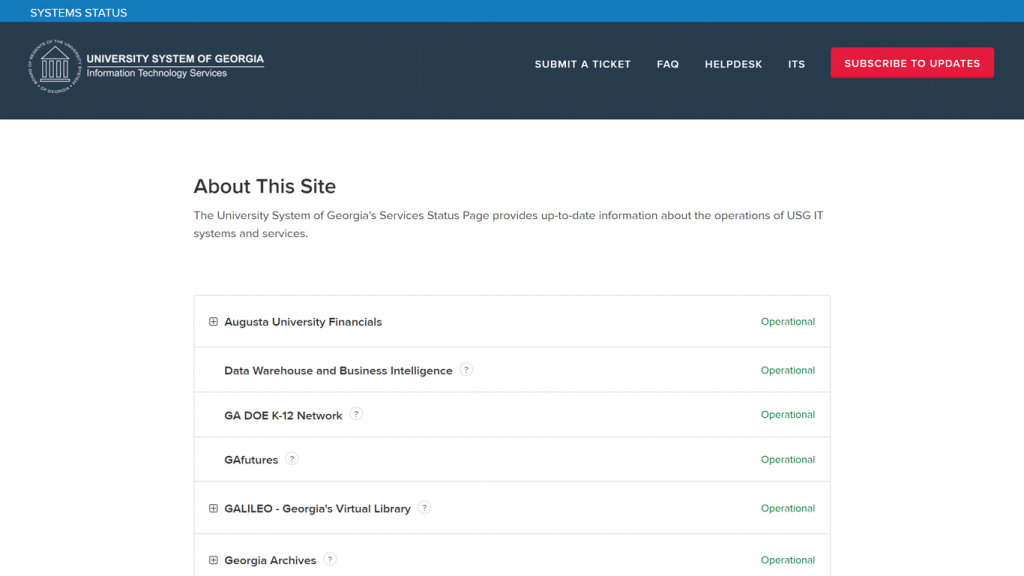
Status Page: https://status.usg.edu/
What They Do: They are a public university system based in the US State of Georgia. They include 26 educational organizations including colleges, universities, the Georgia Archives, and the Georgia Public Library Service. This covers over 300,000 students in the state of Georgia.
What’s Great About Their Status Page? USG aggregates all the statuses and components of all the educational organizations in Georgia into one place. It saves time for students, applicants and staff to find out about any issues for the specific organization or service.
Their status page covers many system components and attributes. All these components have icons explaining what they are to make navigation easier for users. Each component has a dropdown icon for users to see individual sub-components of that system and their statuses.
A subscribe for updates button is available. Also, FAQs and a button to submit an IT ticket are clear and accessible at the top of their status page.
A 2-week incident history is available, with lots of information for the two weeks. However, a timeline of incident history extending past 2 weeks would be beneficial for transparency.
There is an overall lack of a color scheme to lighten up their page. Typically, Atlassian status pages allow color or a banner. USG could take advantage of this feature and bring in some color to separate incidents, downtime, and maintenance. Currently, they only have green for operational and orange for issues.
Overall, their status page is informative for students to find out why they might be experiencing issues. However, the visual aspects of their page could be improved to provide an instant hint with the help of a color scheme. Additionally, an extended incident history would be beneficial.
3. Harvard University

Status Page: https://status.huit.harvard.edu/
What They Do: They are a famous Ivy League University that has over 22,000 students. IT services for the entire Harvard community are covered on their status page. This includes LMS and CMS, as well as multiple networks and technical infrastructures.
What’s Great About Their Status Page? They have an Atlassian status page that displays a list of all their IT systems and their components. This ranges from network services and financial applications to LMS such as Duo and Canvas.
Their IT services and infrastructures are listed in alphabetical order for easy navigation. Icons are found next to some components but not all. This is likely due to some being easy to understand and others not so much (for example, most users will know what Canvas is, but not Active Directory, so this would need an icon). That said, it could benefit Harvard to have icons next to each component.
Sub-components can be found through a dropdown menu, so users can see their statuses too. Incident history is shown on the main page for the past 2 weeks, with an option to view an extended incident history too. Incidents are clear and informative, and a notable feature is that you can filter incidents by specific components, which is beneficial for the user.
Updates are organized clearly and have time marks next to them. Users can easily view an incident and see its timeline, as shown below.
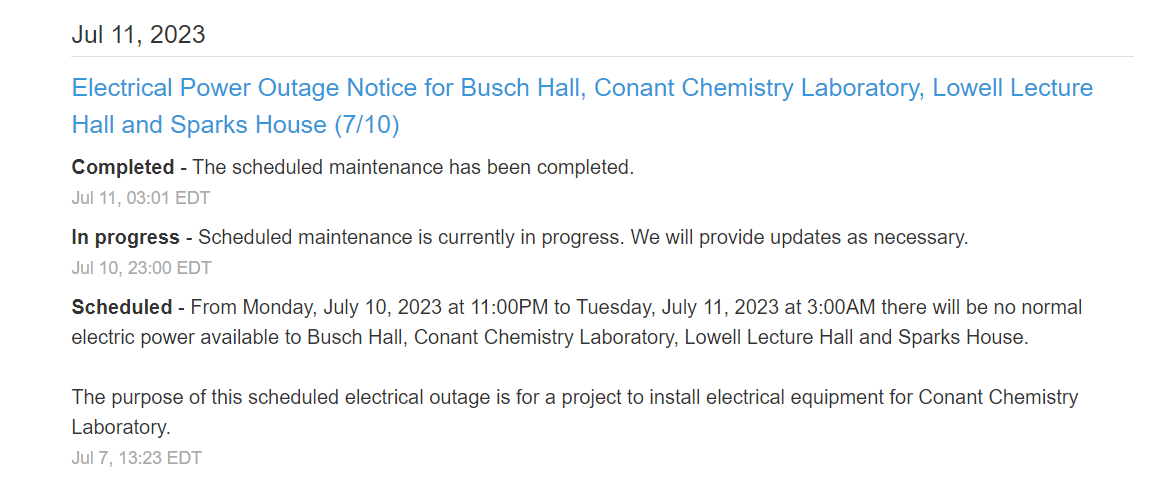
Immediately, we can see their status page matches their University colors and identity. Buttons at the top of the page, which include ‘subscribe for updates’ and ‘request ticket’ buttons, are dark red like the rest of their site. There is also a banner at the top of the page showing the Harvard campus. They have green colors for operational status and blue for maintenance.
Despite blue for “maintenance” and green for “operational”, Harvard doesn’t have a clear color scheme for incidents. In incident histories, there are some orange events, but it is not clarified if these are incidents or outages. Further clarification here would benefit Harvard’s transparency.
Overall, their status page is eye-catching but also informative. They just need a clear color scheme to clarify which incidents were outages, degraded performance, incidents, etc. Bonus points are given for the page being fully accessible for people with disabilities.
4. Massachusetts Institute of Technology (MIT)

Status Page: https://atlas-status.mit.edu/
What They Do: Over 11,000 students study here and rely on various CMS, LMS, and communication services.
What’s Great About Their Status Page? They have an extensive incident history with clear and detailed reports for past incidents. Users can filter incidents by component/service, which is beneficial if they wish to find any trends or consistency with past incidents.
In terms of functionality, the status page example for MIT is similar to that of Harvard. They use the Statuspage by Atlassian too.
MIT displays the past 2 weeks of incidents (daily), with an option to view an extensive incident history for 3 months at a time. Incidents are detailed and informative but are also laid out appropriately and are easy to read. With time marks, users can easily understand the timeline of the incident and what was done to fix the issue.
Scheduled maintenance can also be seen, separate from incidents so it is more easily available to readers. A subscribe to updates button is also available.
One room for improvement is the specificity of each service/component. Some components, such as email and network, do not have any subcomponents or dropdowns. However, we know that there are multiple components and attributes to these services. If an incident occurs, users wouldn’t be able to see which element of these services would be experiencing issues. Some services, such as Zoom and Slack, do have sub-components being monitored. Furthermore, there are only 11 services monitored, and given that this is a university, it’s hard to believe this covers everything.
In terms of visual aspects, MIT’s status page could be improved. They have their logo at the top of the page, which is a good touch to show the page represents MIT. However, it is too big and takes up ⅓ of the page. It means users have to scroll down more than they would need to if it was better formatted. See below.
Additionally, we can see a color scheme in incident history, but it is not defined what the color scheme means. Going through the page, we saw red, orange, yellow, and blue incidents. We can see blue is maintenance, but as for the other three colors, the difference is not obvious. Based on our subjective analysis, it seems that red means outage, orange means incident, and yellow means disruption. However, this is only speculation, and it would benefit MIT to clarify this.
Overall, their status page is informative and detailed when it comes to incidents and maintenance. However, their logo needs to be reduced in size, and a clear color scheme is needed. The services that they offer and monitor could also be more specific.
SaaS and Software Status Page Examples
1. TrackSSL
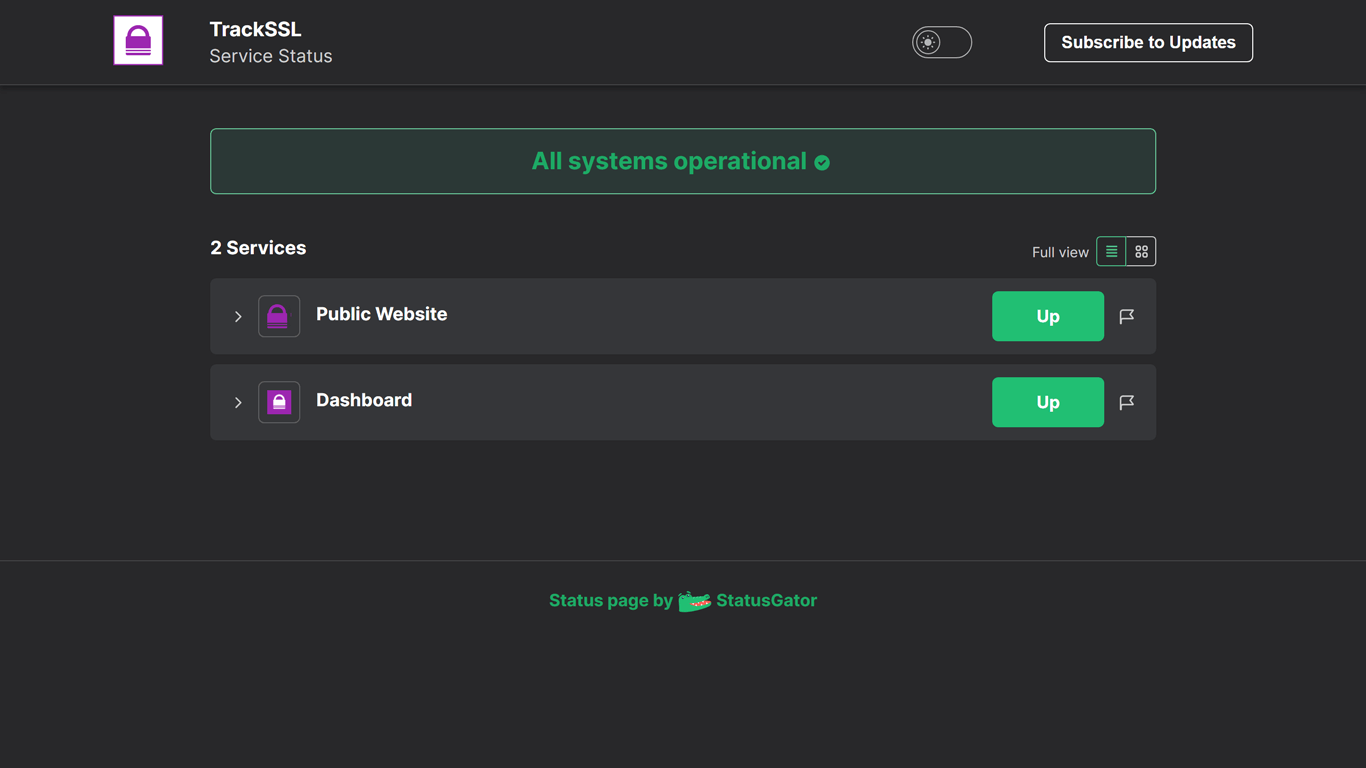
Status Page: https://status.trackssl.com/
What They Do: They are a SaaS company that offers monitoring tools and services related to SSL certificates and their renewals. Their monitoring helps users track their SSL and its expiry. They notify users in the event of changes that can help with transparency and protection from downtime.
What’s Great About Their Status Page? They have an eye-catching status page with multiple features and easy navigation.
One of these features is a dark mode, which is a rare feature and not usually offered by other status page providers, such as Atlassian status pages. They also have a flag icon next to systems for users to raise any issues. They have a subscribe button at the top of their page as well as their logo. With this, combined with StatusGator’s color scheme, they have an eye-catching status page.
Another feature is a handy button that can switch between grid and compact view. In this case, there are only two services (Website and Dashboard), but this is a useful feature to include on a status page. Despite only 2 services being shown, since they use StatusGator, any future services they wish to monitor can be shown in the same place.

On top of this, there is a drop-down menu to see the past 30 days of incident history. However, TrackSSL is amongst the few status pages to display a clear color scheme when it comes to incident history.
One room for improvement would be to display longer periods of historical uptime to boost transparency.
2. Quickbase
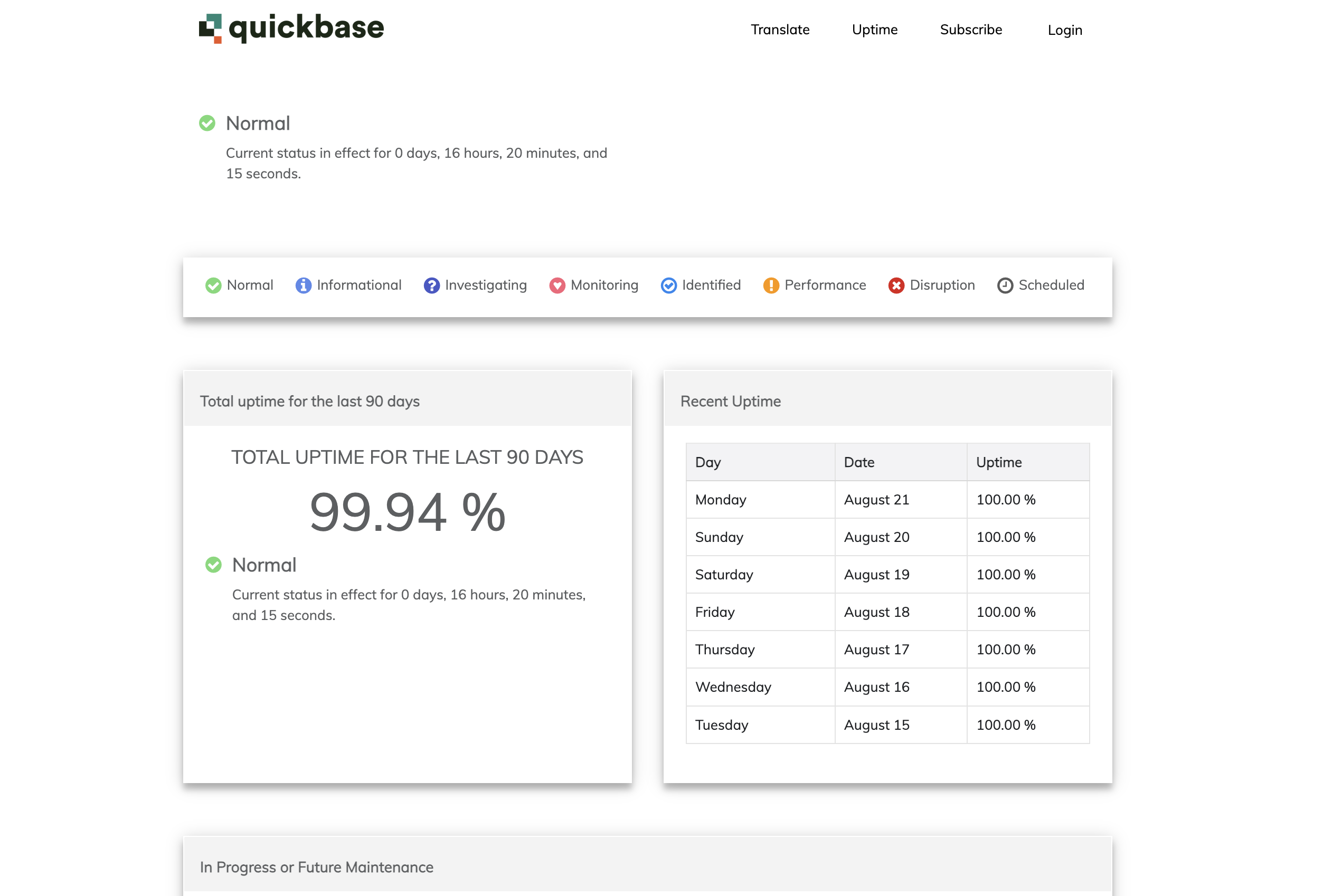
Status Page: https://quickbasestatus.status.page/#!/
What They Do: They are a platform used by teams and collaborators to create applications for their business needs. They have no-code development strategies and a dashboard that accumulates all elements of their projects into one place.
What’s Great About Their Status Page? It offers a clear and informative color key, with a high level of detail for previous incidents.
Alongside their color key to classify incidents, they have a large box displaying the % uptime for the past 90 days. There is a section for current or future maintenance so that users can distinguish between maintenance and past incidents. Another beneficial feature is that they have a 7-day history, including the current date. There are small clock icons on some of the dates, and this brings up a popup with a detailed, compact event to explain the ongoing incident/maintenance. See below.
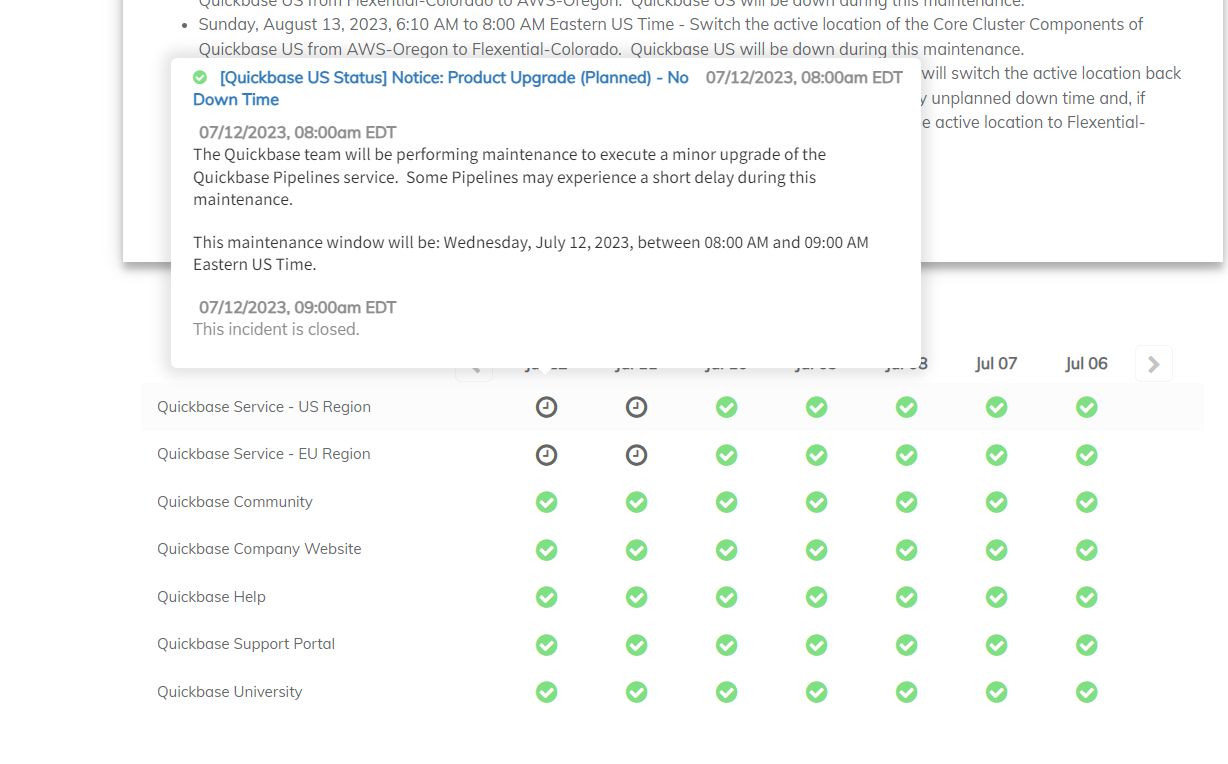
Other useful features on their page include a translate button, a subscribe button, and an option to view uptime history. This uptime button is not commonly seen on status pages.
One notable room for improvement would be recent events. Events are detailed and well-structured. However, they are on the main page, and it is a very long list and takes the user a long time to scroll all the way down. If you wanted to find a particular event for a particular day, it would be difficult to do so.
Overall, their status page has a very clear color key and attributes that help a user navigate the page. However, the list of recent events could be better organized. It could be done using a filter or an option to show/hide the full list.
3. Datadog
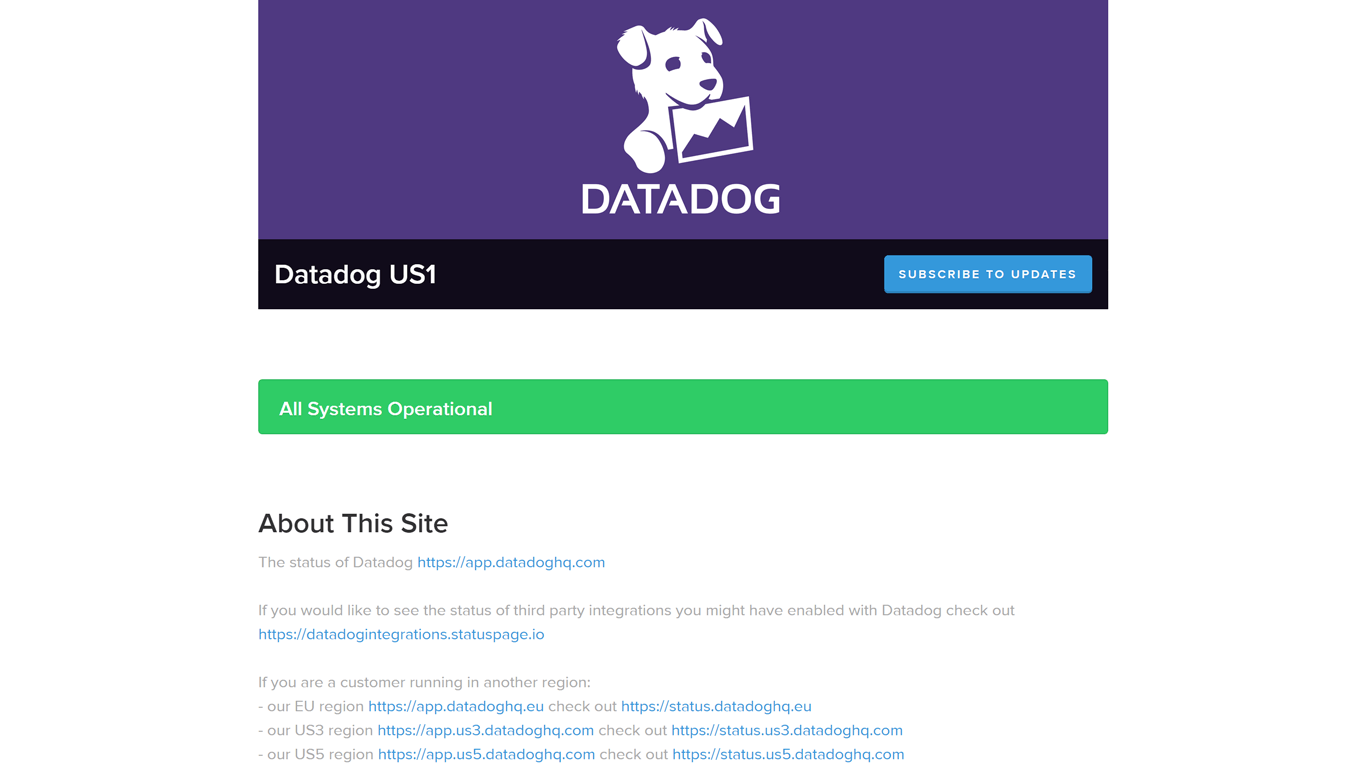
Status Page: https://status.datadoghq.com/
What They Do: They are a monitoring-as-a-service company that offers monitoring tools, primarily for analytical and metric purposes. Datadog collects information from a variety of sources and unifies it into one place. Users can then customize their dashboards to facilitate the analysis.
What’s Great About Their Status Page? They account for their customers/users in different geo locations by offering links to region-specific status pages. Another link for the statuses of their third-party integrations is available. These links go a long way toward transparency.
The Datadog status page clearly displays a color key to categorize events. It is beneficial for users to visualize how much maintenance, downtime, or issues Datadog experiences – another step toward transparency.
Their components and their statuses are listed, but there are no icons to explain what they are. It isn’t vital, but as seen in previous status page examples, this can be beneficial for users. They have a 2-week incident history with the option to view an extended version of their incident history. They also have a subscribe to updates button.
Visually, their status page is clear and easy to navigate. They display their logo, but similar to MIT, their logo takes up too much of the page. It would be much more visually effective if it was more compact, meaning users would not have to scroll down. That said, their status page works with their identity and color scheme. Additionally, there are no other images or banners on the page, meaning they have kept their status page minimal.
Overall, their status page accounts for a wide user base and is a more transparent status page example. Their status updates are informative and clearly coded. However, They could have a smaller banner, as it currently takes up almost half the screen when you first visit the page.
4. Amazon Web Services

Status Page: https://health.aws.amazon.com/health/status
What They Do: They are a cloud computing platform and cloud service provider. They have over 200 different services to offer and cover 31 regions with 99 availability zones.
What’s Great About Their Status Page? They have a page titled ‘service health’ which covers an extensive list of all their regions and services. This list is in alphabetical order, with an option to search for a specific service to view its operational status.
Immediately, you can see a sidebar dashboard that allows you to view Account Health or overall AWS Health. From what we can see, account health is the overall status of the services related to you and your account, giving users the option of a personalized status overview.
With the general overview, you can switch between ongoing issues or the service history. You can also enter a specific date range to view the history for that period. It covers the past 12 months of service history. There is also a pop-up window to view account health.
Since there are a lot of services on offer, their status page offers you the option to filter results via the region. Furthermore, you can search for a specific service. If the user scrolls, they can also see a button to view post-event summaries. These summaries could be organized better, maybe separated by region, month, incident type, etc. However, the summaries themselves are highly informative with plenty of detail.
Visually, AWS’ status page is a good example of a minimalist status page. They have a basic color scheme, with a banner at the top that matches their identity (a dark blue theme). However, it is not overbearing nor is it the main feature of the page.
Overall, despite not being called a status page, AWS’ service health page contains a breakdown of the current status of its services. With so many on offer, it is key that AWS provides the option to filter results, which they have successfully done with the option to search, specify dates, and separate statuses by region.
5. DigitalOcean

Status Page: https://status.digitalocean.com/
What They Do: They are a cloud computing platform that offers a range of services for software developers and their collaborators. Their primary service is an Infrastructure as a service (IaaS) for application and web hosting and development. They offer 5 different plans, which they refer to as ‘droplet’ plans.
What’s Great About Their Status Page? Their services are divided into regional and global services. Each regional service category incorporates dropdown menus that unveil the operational status of components across all available regions.
Since they have an Atlassian status page, they have included the optional button to view a page with incident history. This page shows 3 months at a time, and the months shown can be changed.
Their clear use of a color code to separate what type of events they record (Critical, Major, Minor, Maintenance, Retroactive) goes a long way toward transparency and makes it easy for the user to navigate incident history.
There is also an option to filter incidents by component (API, Billing, DNS, etc.). Reports and status updates are also informative with a high level of information alongside time stamps.
They have two handy buttons at the top to subscribe to updates and also view a Twitter account dedicated to status updates. Other than a color code, there is no color scheme or tailoring of the page to DigitalOcean’s identity. It isn’t a bad thing, however, as the page is clear and straight to the point. A good status page is one that a user can visit and quickly see any updates or issues, so the color scheme is not a vital factor.
Overall, their status page has an effective use of a color code to separate incidents. Furthermore, other features such as a filter button, regional, and global services being separated and highly detailed status updates all help with transparency. The only room for improvement could be the enhancement of its visual aspects, perhaps with an image or banner.
6. Docker

Status Page: https://www.dockerstatus.com/
What They Do: They offer various platform-as-a-service (PaaS) products that package software into containers to be used quickly. Users can then use these containers to build, run, and develop applications. Developers can then share and collaborate on application projects with all their tools and software in one place.
What’s Great About Their Status Page? Alongside the statuses of its key services and components, Docker offers a metric section with a timeline of the uptime and response times for certain components/services. It is a unique feature that is rarely seen on status pages. Users can also view metrics for a month, a week, or the current date, with buttons to toggle between views.
These metrics are just below the statuses of their components and services. Each service or component has an icon that provides a breakdown of what is being monitored. This is a useful feature for less tech-savvy users. Incident history is also highly detailed and can be filtered so the user can easily search for more specific events. There is no clear color code, that would be beneficial for Docker.
Visually, Docker keeps its status page simple and clear. They have a dark blue banner at the top of the page with their logo, hinting at customization of their status page.
Overall, their status page is easy to navigate and includes the beneficial metrics feature, but it could be more transparent by having a clear color code for users.
7. Heroku

Status Page: https://status.heroku.com/
What They Do: Similar to Docker, Heroku is a cloud-based PaaS for developers to create, develop, and scale applications. They support multiple different programming languages to support container-based app development.
What’s Great About Their Status Page? Their status page is straight to the point and displays any incidents and downtime clearly so users can quickly see if there is an issue. Events are the first thing a user sees on the status page.
Updates are informative and provide a relevant level of detail. They also provide a list of the specific components affected by the event. For example, you can see scheduled maintenance affecting certain dashboards in the image below.
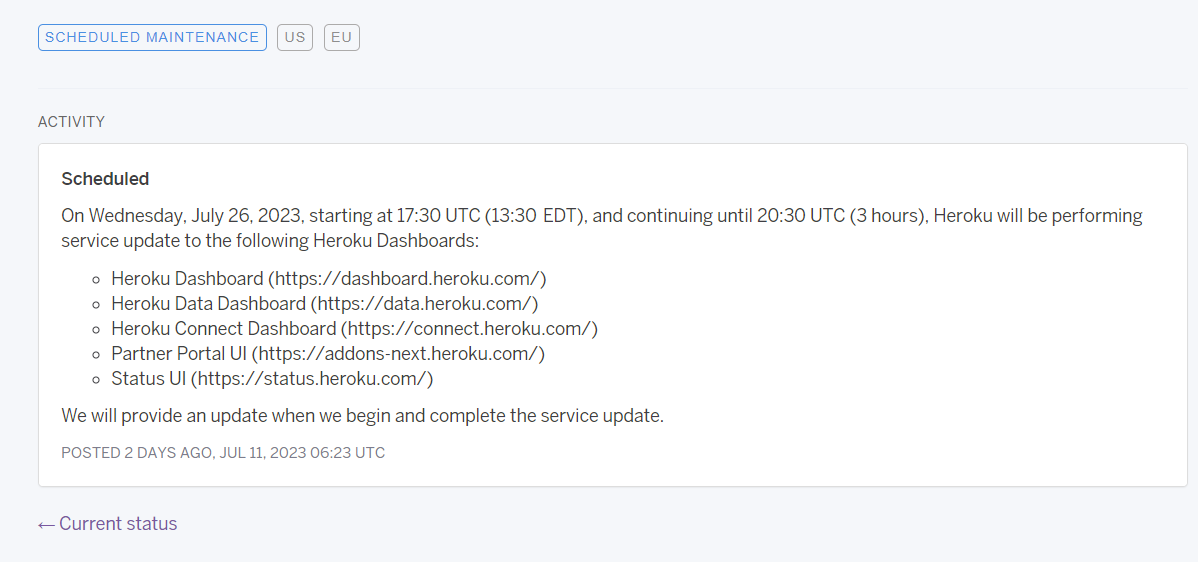
Recent incidents are listed in detail. If a user wishes to see an extended incident history, they can click on archives – a button, that leads the user to an extensive list of past events. There are up to 134 pages of past incidents, and whilst this is good for transparency, a filter or search bar would be hugely beneficial for users to narrow down specific incident types or specific events. Furthermore, a color code would be beneficial.
At the top of their status page is a blue and purple banner that includes their logo. There is also an option to subscribe to updates. You can also click on icons to view Apps, Data, and Tools. However, this isn’t that useful, as it only navigates you down the page slightly to see the status of these 3 services. Heroku only displays the operational status of these 3 categories.
Overall, Heroku is transparent. They have provided an extensive incident history, with all the useful information. However, functionality can be improved by adding a filter, a search button, or displaying more categories of systems and components being monitored.
8. Cloudflare

Status Page: https://www.cloudflarestatus.com/
What They Do: Cloudflare provides website optimization, security, and performance services. They are primarily known as a content delivery network platform and one of the most popular CDN providers.
What’s Great About Their Status Page? Their status page contains statuses of services and geographical regions. For example, there are separate dropdown menus for different continents, as well as the Middle East and Latin America/Caribbean.
The categorization of these regions by continent/region makes navigation for users easier. Users can simply scroll to their region to see its current status. If they are interested in a particular service, they can use the dropdown menu for service statuses.
Under these menus are sections for scheduled maintenance as well as past incidents. These sections contain sufficient detail and make it easy for users to understand the event that has occurred or is planned. There is no subscribe option, but there is a button for support.

Whilst the page is informative, it can be difficult to navigate once you scroll past the status dropdown menus. The list of past incidents is very content-heavy, and it takes a while to scroll all the way down. Since the button to look at extensive incident history is at the bottom, it can be inconvenient for users to navigate to.
Overall, their page is simple and informative, and the categorization of statuses by region is a plus. However, there is a lot of information regarding past incidents on the first page, so scrolling takes a while. Since there is an option to view incident history anyway, it might make more sense for Cloudflare to only show past incidents for a smaller period, for example, 2 weeks.
9. Segment

Status Page: https://status.segment.com/
What They Do: Segment is a data management platform that collects, cleans, and ‘activates’ their customer’s data. Over 25,000 businesses use Segment for data management purposes. With Segment, businesses can gain analytical insight into their customers.
What’s Great About Their Status Page? Not only does it cover status updates and metrics, but it’s also well-organized and easy to navigate.
Firstly, their Atlassian status page shows the current status of their services alongside a 90-day uptime history. You can also click an icon that drops the menu down to show the status of the components. Users can see the metrics section in these drop downs, similar to the Docker’s status page example. You can view metrics for certain attributes, such as API latency and API response time, for the current date, or last week of the past month.
A 2-week past incident history is available under the metrics section. There is also an option to view an extended incident history. Users can use the filter setting in incident history to make navigation to specific incidents easier. Additionally, you can view uptime history in grid view as well as incident history.
This factor, alongside metrics, indicates transparency on Segment’s behalf. You can also subscribe to updates and notifications. Incidents and updates are detailed and informative but would benefit from a color code to categorize events.
10. Twilio

Status Page: https://status.twilio.com/
What They Do: Twilio is a customer engagement platform that allows users to create and personalize their communication infrastructures. With Twilio, you can customize your communication preferences to your customer base.
What’s Great About Their Status Page? They provide lots of information on their status page, but they have buttons at the top that automatically navigate you to the appropriate page section. For example, they have a maintenance button, which will automatically guide you down the page to the maintenance section. This makes it easier for users to navigate through a large amount of information.
On top of this, their Atlassian status page has buttons to subscribe and contact support in the top right of the page. They also have the option to report an incident. The navigation buttons include Current Status, Scheduled Maintenance, and System Metrics. Clicking on current status brings you to two sections – Twillio Services and External Connectivity. These sections contain an extensive list of monitored systems.
The Past Incidents button links to a separate page with an extensive breakdown, showing 3 months at a time. Incidents are detailed and can be filtered for faster navigation. However, they would benefit from a clear color code to categorize incidents, similar to other status page examples that we looked at.
Visually, their status page is kept minimal and does not have a color scheme or banner of any kind. However, they do have their logo on the top left of the page.
11. GitHub

Status Page: https://www.githubstatus.com/
What They Do: GitHub is a cloud-based service for version control using Git. Users can collaborate on open-source software projects by being able to store, manage and share their code with other users.
What’s Great About Their Status Page? The most commonly used GitHub components and services (such as Git Operations, Webhooks, Pull Requests, etc.) are displayed first so their status is immediately available to users. There are hint icons next to each component to explain what they are, which is useful for less experienced users.
To view all the components and locate incident history, a user will have to scroll.
Incident history shows three months at a time. If there are more than 2-3 incidents, viewers can expand the history of a particular month to see more.
One immediately noticeable attribute of their status page is that it has a minimalistic branded banner at the top of the page. This is a nice touch as it shows they have spent time tailoring their status page to their identity.
However, because of this, users need to scroll a page down. Given there are only 10 components displayed, this layout could be improved. You cannot click on the components to display more information either. Status pages should have as much detail as possible including sub-components, regions, or more granular detail.
Furthermore, there is no clear color scheme that you would expect on a status page (red=down, yellow=warn, etc.). Incidents appear to be highlighted in dark orange or yellow, but there is no information describing what the difference is. Some incidents are simply in black text – so it is not clear if it is an incident or maintenance.
Overall, it’s not a bad status page, considering timely updates, and minimalistic design to a certain degree. However, as we mentioned before in our extensive research on GitHub outages, more information could be provided to improve transparency.
12. Litmus
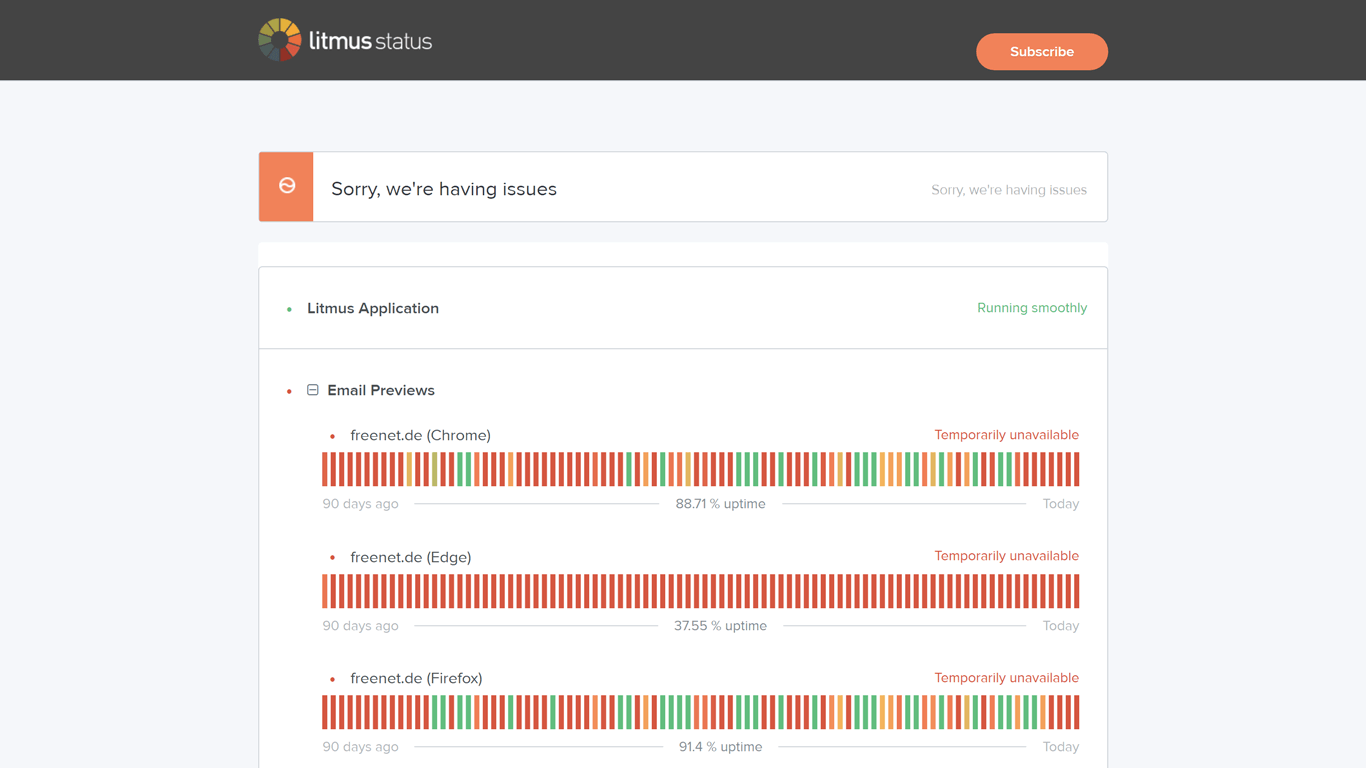
Status Page: https://status.litmus.com/
What They Do: Litmus is a marketing platform that allows users to create, personalize and tailor their customer emails. As a result of optimizing their emails with Litmus, marketers are more likely to get the most out of their email chains.
What’s Great About Their Status Page? Their Atlassian status page is tailored to their identity without being the main takeaway of the page or an overbearing feature. They have a subscription button and their logo. Additionally, there is a banner at the bottom that includes professional graphics that have been designed to match their identity.
Despite this, the rest of the page is neutral, meaning these features relating to their identity do not take over the page.
Status information for their services is listed with a 90-day uptime in the form of bars, similar to other status page examples we looked at such as Reddit.
Their incident history is extensive. Similar to other status page examples that use Atlassian’s Statuspage, they show 3 months at a time and let the user change the period shown. Components can be filtered to help users navigate incidents. Uptime history can also be viewed.
Overall, they display a compact view of 90-day history, which is a positive feature aimed at transparency. However, when we viewed their page, they were experiencing “issues” according to their statement. Ideally, the main message that communicates the current status should be clear. Was it an outage? Was it a partial outage? Upon expanding Email Previews, we saw that the service was temporarily unavailable. It would be beneficial if the main message communicated clearly that their Email Previews were temporarily unavailable. If the issues affected their Instant APIs or Labs services, users would not see it on their first screen and would have to scroll for details. Another suggestion we could make is to provide information icons next to each service to explain them non tech-savvy users. Some services have this icon, but it would be beneficial to add them to other services.
13. NoCodeOps
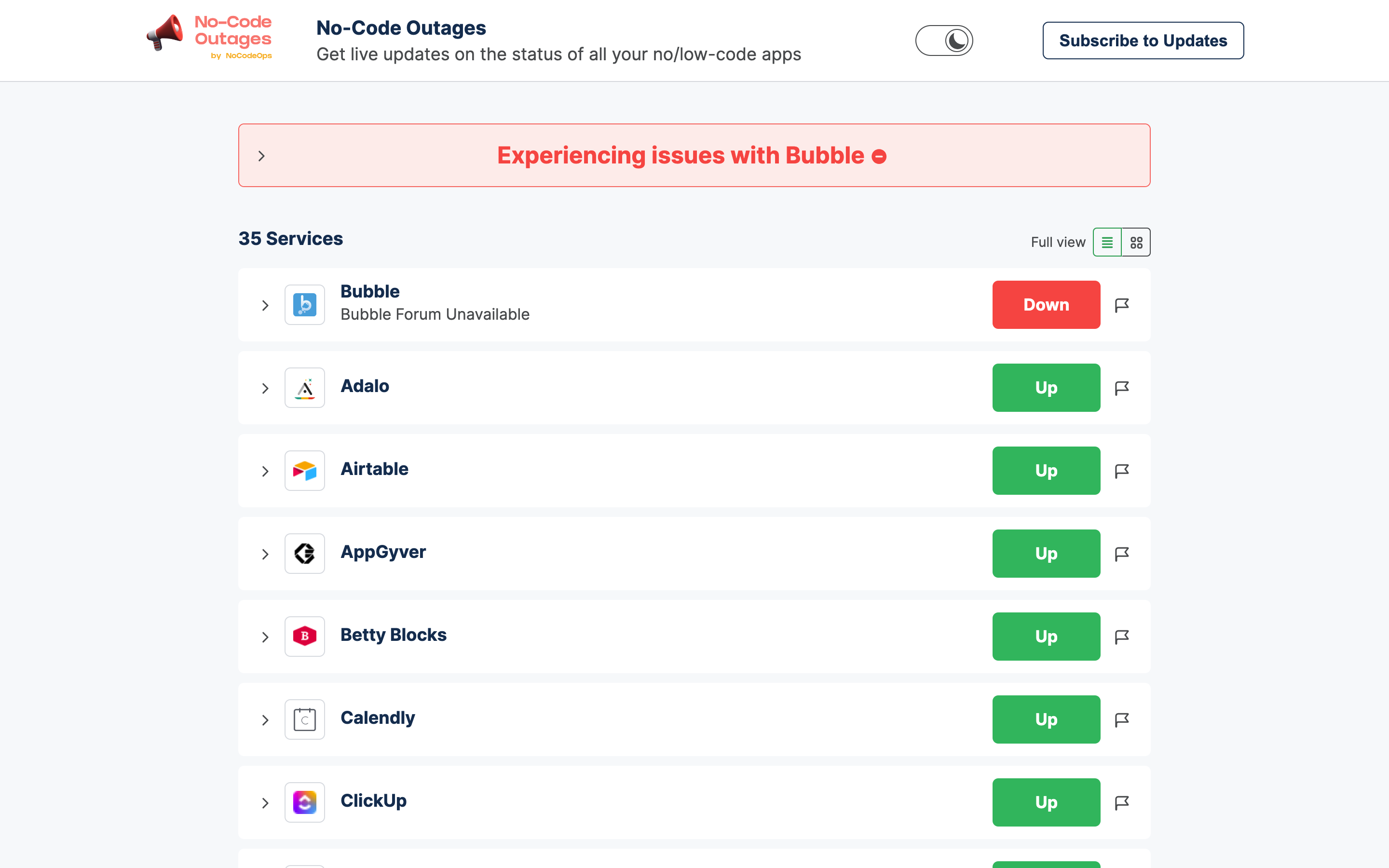
Status Page: https://www.nocodeoutages.com/
What They Do: NoCodeOps, a tool for no-code developers, uses StatusGator to monitor popular services and no-code tools and aggregate them into one place for convenience.
What’s Great About Their Status Page? NoCodeOps monitors 35 different services. These services are listed on their status page with drop-down menus showing the status of individual service components. Users can switch to the history tab for each service, which displays a 30-day uptime history with a clear color code categorizing events.
Furthermore, the page is eye-catching but remains functional and easy to navigate. There are buttons to switch to dark mode, and an option to switch between grid and compact view.
Users can subscribe to receive instant updates. There is also a flag icon next to each service to report any issues.
However, one room for improvement would be for NoCodeOps to display an extended incident history. This would work toward further transparency and help users gain insight into reliability. They have a not-very-typical name for their status page – NoCodeOutages. It may confuse as users would search for “status page”.
Overall, NoCodeOps has a clear and transparent status page with all its services and third-party services listed. Incidents are updated with detail and the page is easy to navigate, with many features helping with functionality. Possible improvements would be for NoCodeOps to display a more extensive incident history and have a typical naming for their status page.
Community and Communication Status Page Examples
1. Reddit

Status Page: https://www.redditstatus.com/
What They Do: Reddit is a well-known social media platform that allows networks of communities to discuss and share social content.
What’s Great About Their Status Page? Their Atlassian status page displays both historical uptime and extensive incident history. 3 systems are being monitored:
- Reddit.com
- Reddit Infrastructure
- Reddit Media Storage
Reddit.com covers all attributes of the website, such as vote, spam, and comment processing. These components can be seen when the user clicks on the drop-down icon. The status of each component is paired with a 90-day uptime history in the form of bars. There is no explanation of the status color code, though. We can assume red means an outage and orange means an incident, but this isn’t clarified.
There is a 2-week incident history and a link to a more extensive list that shows 3 months at a time, and the user can edit the dates shown. Incident reports are detailed and informative, with appropriate time stamps.
Overall, their page is easy to navigate and shows a good amount of information. They have a subscribe to updates button and their logo to match their identity. However, like some other status page examples we have looked at, it would be beneficial if their logo was smaller. This is not a big issue, however.
2. Skype

Status Page: https://support.skype.com/en/status/
What They Do: Skype is a well-known communication software that allows users to make free video calls. They have around 300 million monthly active users.
What’s Great About Their Status Page? Their status page is tailored to their identity with a blue theme but remains minimalist too. They have a large blue banner at the top of the page which shows the service is functioning normally. Additionally, there is a blue button underneath that can be used to raise an issue. This is obvious to the users and is a useful feature to include.
Additionally, the services being monitored are listed alongside icons detailing what exactly that service is. The current status of that service accompanies these. There is also a menu above the page banner which has buttons for Downloads, Skype to Phone, Skype Number and Skype Support.
However, there is room for improvement. There is no option to view incident history or uptime. Only the current statuses of their systems are shown. This would be beneficial for Skype’s transparency, as many other status page examples have this included. There is also no option to subscribe to updates.
Overall, it is a straightforward status page tailored to Skype’s identity. However, it has room for more information, namely incident history.
3. Slack
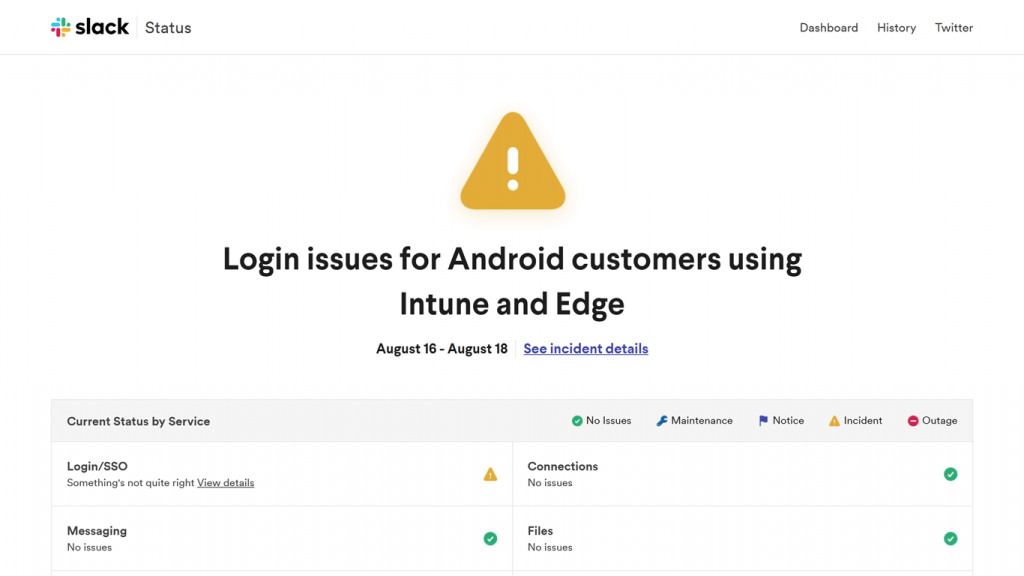
Status Page: https://status.slack.com/
What They Do: They provide an instant messaging platform for business communications. With Slack, many organizations can communicate more efficiently and securely in the workplace.
What’s Great About Their Status Page? Their status page is straight to the point with a clear color code and a list of services with statuses. Additionally, there’s a display of the quarterly uptime in percent. They also have a link to report an issue under the main page heading, so it is easily available to users who wish to report an issue.
There are Dashboard, History and Twitter buttons in the top right corner.
- The Dashboard leads you back to the status home page
- History leads you to the extensive reports on past incident
- Twitter leads you to Slack’s Twitter account dedicated to status updates
Their incident history covers one year. This may not be as extensive as other status page examples in this list, but it still covers all events (Maintenance, Incidents, Outages).
However, one room for improvement is to make events more obvious. The history shows a calendar view, and icons to display events are on the smaller side. See below. As you can see, the icons could be made more obvious, perhaps with highlighting or with different colors.
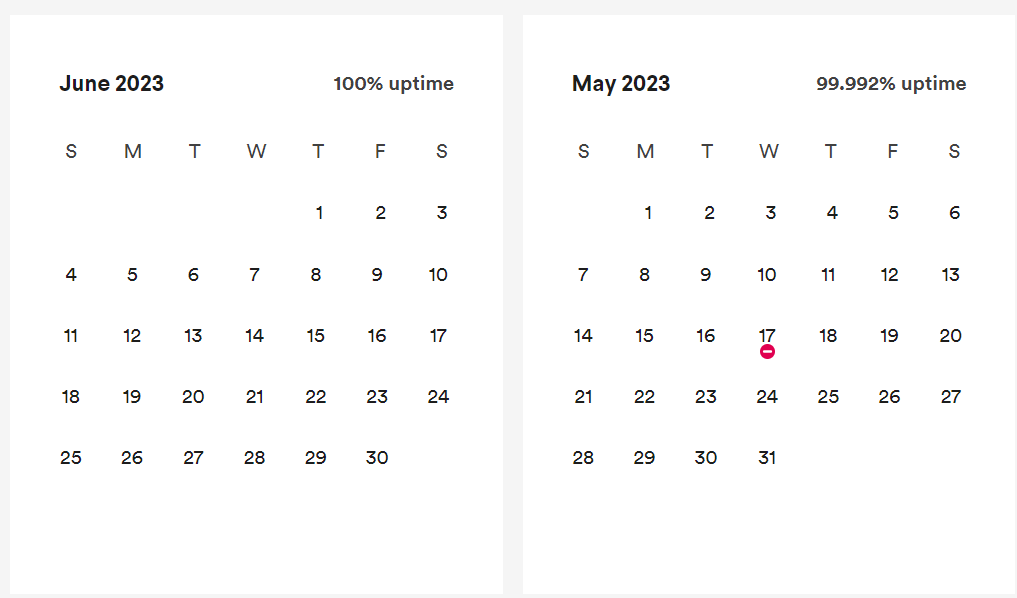
They have a link for users to troubleshoot their issues, which is a unique feature. They also have some text under the status data where users can click to subscribe, but this could be made more obvious.
One additional suggestion for Slack is to show planned maintenance events. It would be beneficial to users so they can plan around these events.
Overall, this status page example gets straight to the point. However, some changes could be made to make features more obvious, such as the subscribe section and incident history icons.

Fintech Status Page Examples
1. PayPal
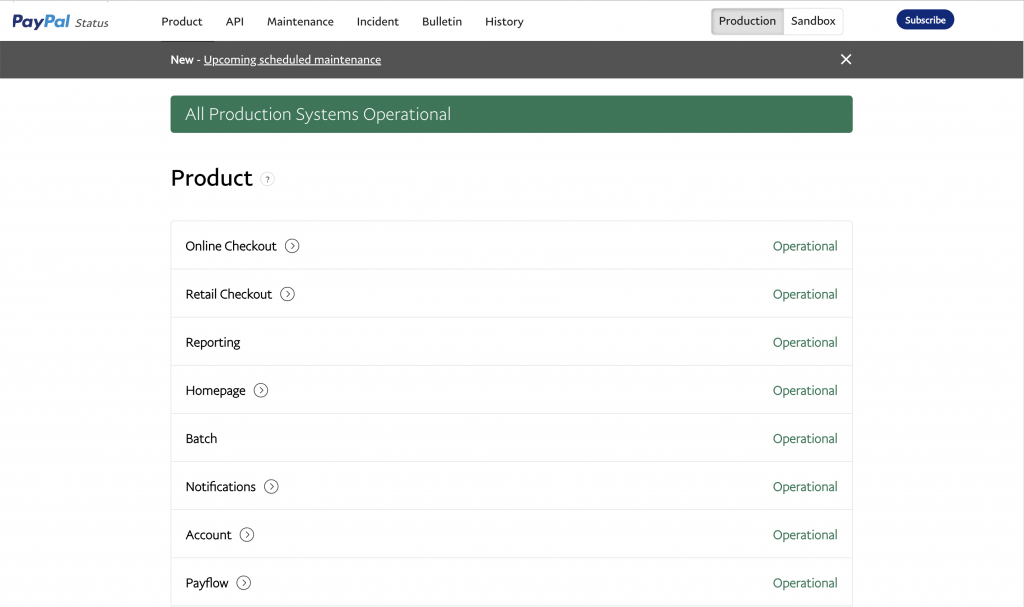
Status Page: https://www.paypal-status.com/product/production
What They Do: PayPal is a world-famous online payment system. PayPal products and services range from online checkout services to cryptocurrency transactions. They operate over 430 million active accounts in more than 200 countries, with an estimated 35 million being merchant accounts.
What’s Great About Their Status Page? PayPal’s content-heavy status page has sections split into tabs for easier navigation. Users can also switch between production and sandbox status updates.
The first tab is the Products, which lists components such as online and retail checkout, notifications, etc.
API statuses are in a separate tab and include types of APIs PayPal uses with their sub-categories statuses.
There’s a tab for incidents and a separate one for maintenance.
There is a handy bulletin tab that addresses any recent incidents if a user wants details. The final tab is an incident history for the past 60 days.
Their 60-day incident history chart distinguishes between incidents and downtime. However, their incident log only has small, faint icons that could be more obvious.
Service statuses and a subscribe button in the top right of the website could be more eye-catching. PayPal has handy pop-up windows to guide users through their status page, but these can delay a user getting information regarding an incident if it’s not their first visit.
2. Coinbase
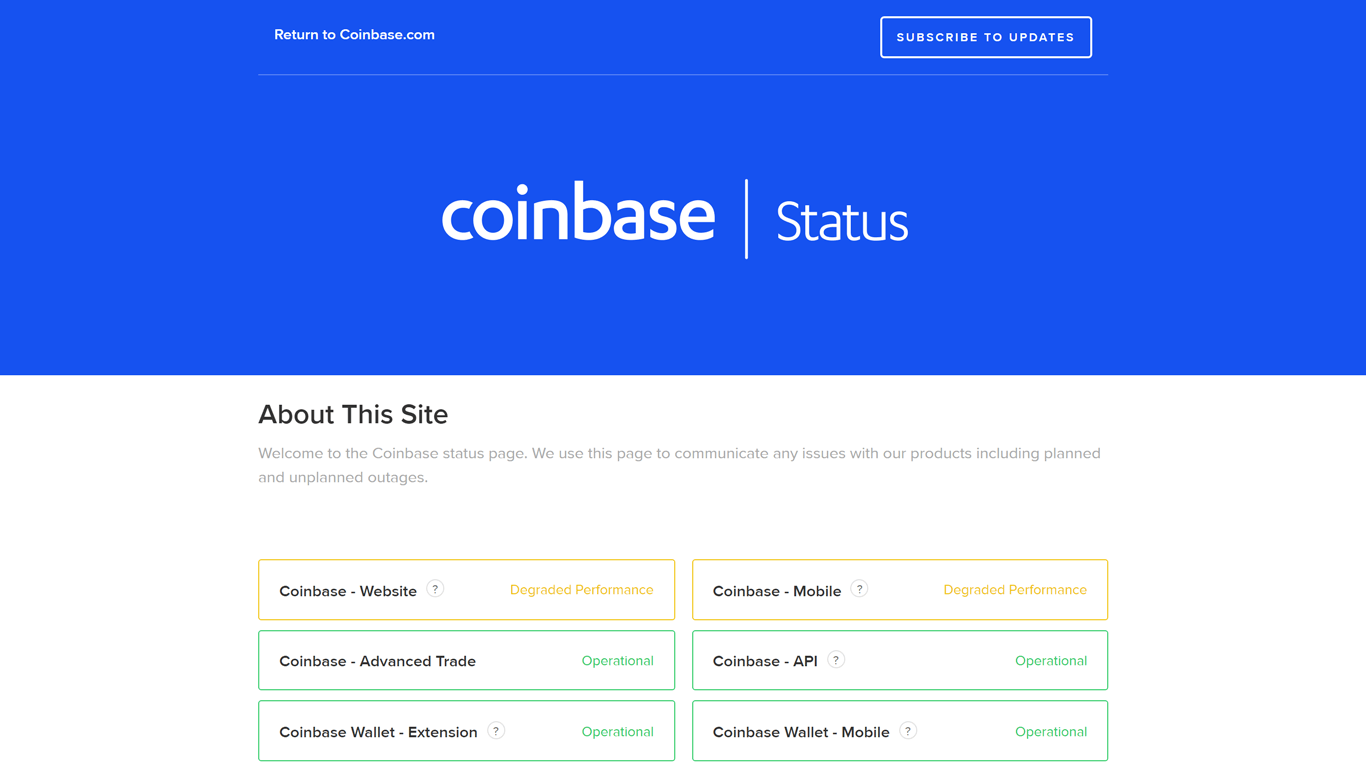
Status Page: https://coinbase.statuspage.io/
What They Do: Coinbase is a secure online platform for the exchange and management of cryptocurrency.
What’s Great About Their Status Page? Their status page has an extensive list of systems being monitored, with dropdown menus showing the statuses of individual system components.
Users can easily navigate between the statuses of the components. There are icons next to each component that inform on the component’s functionality upon the hover of the pointer.
Since they have an Atlassian status page, Coinbase displays an extensive incident history showing three months at a time. Users have the flexibility to adjust the date range according to their preferences. However, unlike some of the other examples of Atlassian status pages we’ve discussed earlier, there’s a missing filter option here. It would also greatly enhance clarity if incidents were color-coded for easy categorization.
The status page welcomes users with a prominent blue banner featuring the Coinbase logo. While this aims to provide information, the banner’s size hampers immediate visibility of statuses. To optimize user experience, the banner could be resized, allowing statuses to be promptly accessible. The subscription button blends in with the blue background. It would be more visually effective if it was designed to stand out.
Overall, Coinbase’s status page is efficient in conveying essential information and incident history. However, there’s room for visual and functional refinement. Specifically, a more compact blue banner, adding a filter option in the history view, and a more visible subscription button could enhance the page’s usability.
3. Intuit
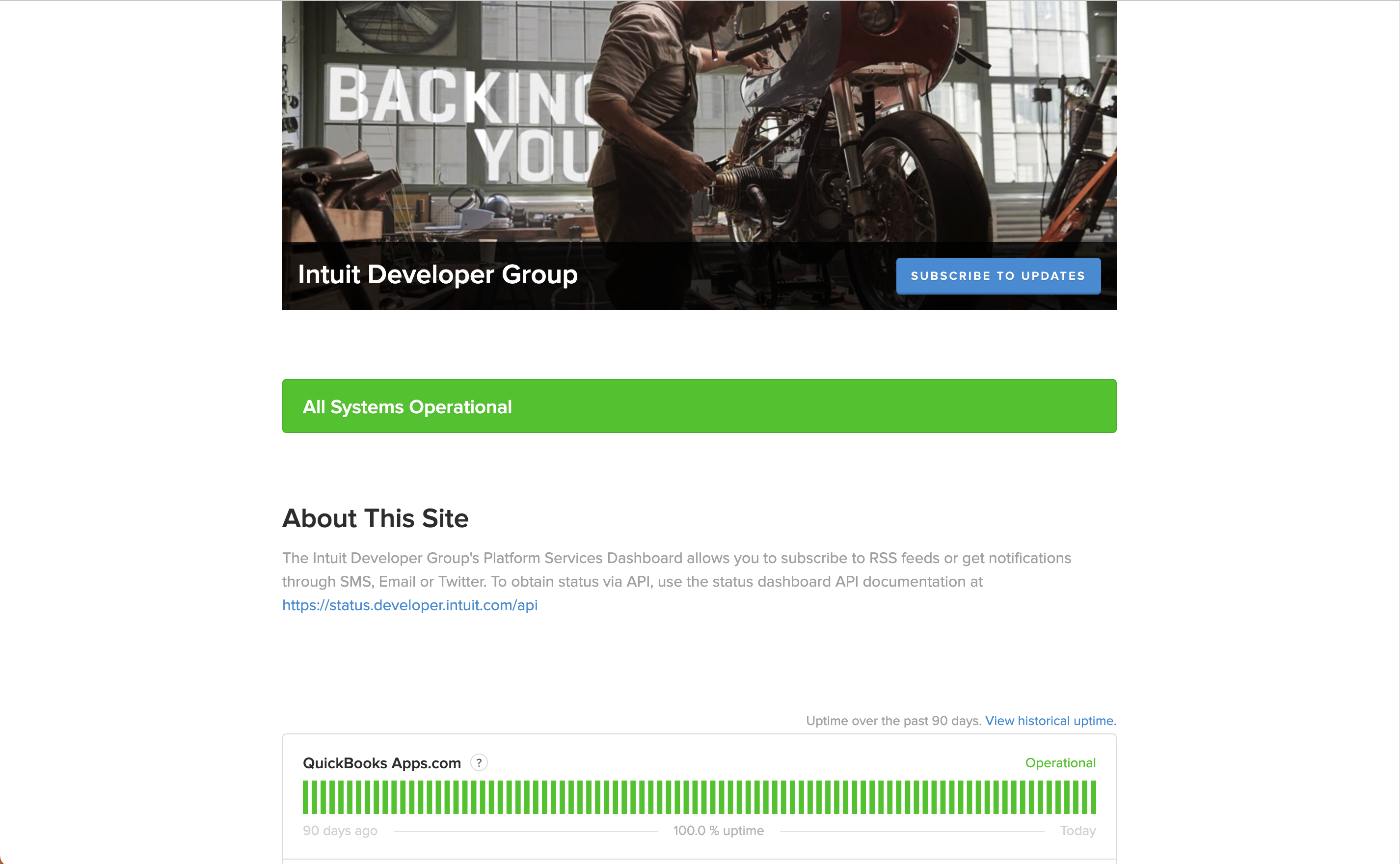
Status Page: https://status.developer.intuit.com/
What They Do: Intuit is software that aims to make financial management for businesses easier.
What’s Great About Their Status Page? Their status page displays a compact view of a 90-day uptime history for each service they provide. Additionally, they have information icons next to each service to explain what each service is.
There are 2-weeks of historical overviews under the lists with Intuit services.
Incident and uptime history are available upon clicking the small link either above the list of the service or at the bottom of the page. In case this is the main interest of the user, they can access history without scrolling the page down. But the link could be more prominent. Like most status page examples by Atlassian’s Statuspage, you can see the default 3 months at a time. Users can also filter search results and change the period shown. Incidents follow a clear and scalable timeline and have sufficient amounts of detail to explain incidents.
One unique aspect of this status page example is that there is a link to a separate status page for developers. It is a useful feature for users, as whilst it is not a typical status page, it can provide developers with useful information regarding system status. Intuit also has a Quickbooks status page. It is not interlinked with the status page for developers, and we wonder if it is made that way for the convenience of Intuit users.
When a user first visits the page, there is an image with a subscribe button on it. The image doesn’t seem related to finance, but it does seem to match Intuit’s identity. On their website, it appears to be images of people in various businesses within various industries. The same applies to their status page, so it seems fitting.
Overall, this is an informative status page, but the formatting and the layout of its contents could be improved. The banner could take less space so that more information was available to users on the first screen.
4. Square

Status Page: https://www.issquareup.com/
What They Do: They offer financial solutions to businesses, primarily for payment processing. This involves a range of software and hardware. They combine in-person and online payment processing to offer businesses an all-in-one solution to manage financials.
What’s Great About Their Status Page? Their page is more eye-catching than many other status page examples, as it uses various-sized fonts and colors to enhance its visual aspects. Next to each component, they are saying ‘Everything’s great!’ instead of repeating their main visible message ‘operational’.
Square incident history and system statuses are well organized and laid out. They are clear, straightforward, and to the point. System names are a bit vague and could be more detailed (e.g. online store could have statuses shown for network, payment processing, basket, etc.). The incident history is also detailed and to the point.
Overall, more visual features would be beneficial, but this is not a drawback as the page itself is still clear and informative. However, during disruption, events become the first thing displayed on the page. Whilst this makes sense to alert users immediately, it does take up a lot of the page and could be less overbearing.
E-Commerce
1. Shopify

Status Page: https://www.shopifystatus.com/
What They Do: They are a leading e-commerce website that helps users, particularly first-time sellers, to promote and sell products online securely. The service is popular with small businesses or individuals for growing and scaling their businesses.
What’s Great About Their Status Page? Their status page is basic and gets straight to the point. It immediately displays the overall operational status of Shopify and has service statuses underneath.
Additionally, like some other status page examples in this list, it offers a clear color code to separate incidents and categorize them.
There is also an option to view previous events. However, this is not a full incident history, which Shopify seems to be lacking. There were no events shown when the recent events link was clicked. It could be an aspect for improvement and help with transparency.
Another point of interest is that there is a comment at the bottom of the page stating the following:
“Some issues affecting a small number of stores may not be reflected here.”
From this, we can infer that not all incidents are recorded. We don’t know this for sure. If there was an issue with a user’s store, there is a chance they would go to this status page and not find any information. It would help with Shopify’s transparency to resolve this issue.

Conclusion
The best status page examples above are varied and all have different attributes depending on the industry. There are no identical status page examples, but we defined features that make a good one.
No.1 is a prominent and informative current status, so users do not flood your support team reporting the same issue. Other features also include clear and detailed incident history and an option to subscribe.
Whatever elements you wish to add to your status page, it helps when it can be done easily. Some status page providers can only offer certain elements or features, so consider what you want your status page to look like first before subscribing to any plans. To play it safe, consider providers such as StatusGator, who provide you with all the tools and features you need for a user-friendly, clean status page with all your dependencies in one place.
FAQ on Status Page Examples
Q: What makes a good status page?
A: There are many elements of a good status page. First and foremost, the key thing is you provide relevant and detailed information regarding the status of your services. A good status page breaks down all the relevant components of your services and displays both their current status and status history. That way, you have transparency between you and your users.
Secondly, a good status page is organized, easy to read, and easy to navigate. If not, it can make it inconvenient for users to try and find out what their issue is. It helps if the page is eye-catching without being overbearing, possibly by including banners or images that are spatially effective and not too large.
Q: What is the importance of a status page?
A: A status page is primarily for transparency between your services and your users. If an issue occurs, your users can head to your status page and understand the issue quickly. Without one, they are left in the dark, and as a result, can lose trust in you over time.
Q: How do I create a status page for my website?
A: If you want to create a status page for your website or business, you need to go to a status page provider. The most common providers in our list are StatusGator and Atlassian. StatusGator allows you to aggregate your services (and third-party services) into one place. It also contains many customizable features that you can use to tailor your status page to your website’s identity.
Q: What should a status page include?
A: By looking at the best status page examples above, we can understand what makes a good status page. Here are some of our suggestions:
- A clear, obvious section displaying the current status for all your key services – this should be at the top of the page and have a clear color code (green=operational, yellow=incident, red=outage, etc.).
- Incident history – a good incident history displays detailed status updates for past events. A color code also helps users understand incidents better.
- An option to subscribe to future updates
- A filter to narrow down search options, either for services or incident history
- A color scheme or page layout that matches your brand without being overbearing (a simple logo will do).
Q: What are the different types of Statuspage pages?
A: Typically, there are three types of status pages you could have:
- Public status pages – for communicating with external customers
- Private status pages – for internal communication, usually with employees, stakeholders, and developers
- Audience-specific status pages – for pre-specified users and groups
Whatever status page you need, you can usually subscribe to specific plans for that particular page. For example, Atlassian status pages come in three different plans for the types listed above.
However, other status page providers can offer you a choice between status pages as part of one plan. For example, StatusGator has a one-plan-for-all-style plan, meaning you can keep track of all your status pages in one place.
Q: What does a status page do?
A status page keeps your users and customers informed of any downtime or issues with your website or platform. Instead of them being kept in the dark when they are having IT issues, your status page can inform them quickly and efficiently. A status page typically displays the current status, and historical data, for key systems or services your website has.
Q: What does a status page include?
A: Every status page example we have looked at shares similarities and differences. However, there are a few key features that almost every status page has:
- Incident history
- Current statuses of all key services
- A subscribe to updates button
- Status updates with detailed accounts of incidents, whether historical or ongoing.



